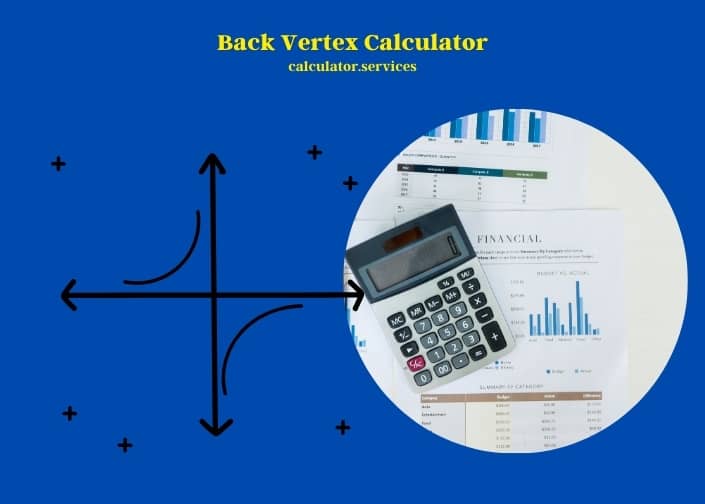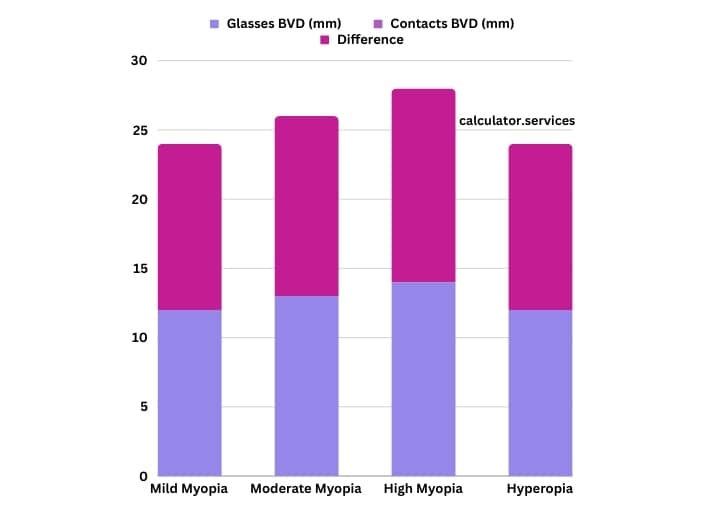Published on: December 17, 2023
Created by Calculator Services Team / Fact-checked by Monjurul Kader
Back Vertex Calculator
COMPENSATED Rx
Back vertex calculators are essential tools in the field of optometry and eyewear. They play a pivotal role in ensuring the accuracy of lens prescriptions, especially when transitioning from glasses to contact lenses.
In the realm of eye care, precision is key. A back vertex calculator is designed to adjust lens prescriptions based on the distance between the eye and the back surface of a lens. This distance, known as the back vertex distance (BVD), can significantly impact the effectiveness of eyeglasses or contact lenses. For individuals switching from glasses to contacts, this tool is invaluable. It recalculates the required lens power, considering the reduced vertex distance in contact lenses, which typically sit directly on the eye’s surface.
Opticians and optometrists rely on this calculator to provide patients with the most accurate and comfortable vision correction. The tool considers various factors, including the original spectacle prescription and the original and new BVDs. By inputting these values, the calculator outputs a ‘compensated Rx’, which is the adjusted prescription for contact lenses. This ensures that the transition from glasses to contacts is seamless, maintaining optimal vision clarity and comfort.
For anyone interested in the technicalities of lens prescriptions or those in the process of switching to contact lenses, the back vertex calculator is a valuable resource. It bridges the gap between different types of vision correction, ensuring that your eyes receive the best possible care. We invite you to read the detailed article below for more insights into how this tool can benefit you in your journey towards perfect vision.

Some useful Calculators:
- Coopervision Toric Calculator
- Earth’s Average Speed Calculator
- Australian Visa Cost Calculator
- Arena Lighting Calculator
- Auger Length Calculator
- Aluminum Coil Calculator
Back Vertex Calculators
Definition and Purpose
Have you ever wondered how optometrists ensure your contact lenses provide crystal-clear vision? Enter the back vertex calculator. This nifty tool recalculates your eyeglass prescription for contact lenses. It’s all about the distance between your eye and the lens, known as the back vertex distance (BVD). This distance changes when you switch from glasses to contacts, and that’s where the calculator works its magic.
Role in Optometry and Eyewear
In the world of eye care, precision is everything. The back vertex calculator is a game-changer for optometrists and eyewear specialists. It ensures that the transition from glasses to contacts doesn’t compromise your vision. By adjusting the lens power based on the BVD, this tool helps in providing accurate and comfortable vision correction.
The Science Behind the Calculation
Comparison of Vertex Distances
Let’s break down how BVDs vary and impact lens prescriptions:
| Prescription Type | Glasses BVD (mm) | Contacts BVD (mm) | Difference |
| Mild Myopia | 12 | 0 | 12 |
| Moderate Myopia | 13 | 0 | 13 |
| High Myopia | 14 | 0 | 14 |
| Hyperopia | 12 | 0 | 12 |

As you can see, the BVD for glasses is significantly higher than for contacts, which sit right on the eye.
Factors Affecting the Calculation
Several factors play into this calculation. Apart from BVD, the original spectacle prescription, including sphere, cylinder, and axis, are crucial. The calculator tweaks these values to compensate for the shorter BVD in contacts, ensuring your vision stays sharp.
Step-by-Step Guide to Using a Back Vertex Calculator
Inputting Data Correctly
Getting the best results starts with accurate input. You’ll need your current eyeglass prescription and the BVDs for both glasses and contacts. Make sure to enter these values precisely – even a small error can throw off your results.
Interpreting the Results
Once you hit calculate, you’ll get a ‘compensated Rx’. This is your adjusted prescription for contact lenses. It might look a bit different from your glasses prescription, but trust the process – it’s tailored for your eyes in contacts.
Real-World Applications
Case Studies and Outcomes
Here’s a glimpse at how the back vertex calculator makes a real difference:
| Case | Original Rx | Adjusted Rx for Contacts | Outcome |
| Near-Sighted Teen | -3.00 | -2.85 | Clearer vision for daily activities |
| Office Worker | +2.50 | +2.35 | Improved comfort while using a computer |
| Sports Enthusiast | -4.50 | -4.30 | Better peripheral vision during sports |
These examples show the practical benefits of using the calculator for various lifestyles.
Advanced Features and Considerations
Limitations and Accuracy
While the back vertex calculator is incredibly useful, it’s not infallible. The accuracy depends on the quality of the input data. Also, for extremely high prescriptions, the calculator might be less effective.
Technological Advancements
The field is always advancing, with new software making these calculations more precise and user-friendly. It’s an exciting time in optometry tech!
So, there you have it – a peek into the world of back vertex calculators. These tools are vital in ensuring your switch from glasses to contacts is smooth and your vision remains top-notch. They’re a testament to how technology is making personalized eye care easier and more accurate. Next time you’re at the optometrist’s, you’ll know exactly what’s going on when they whip out this calculator!
